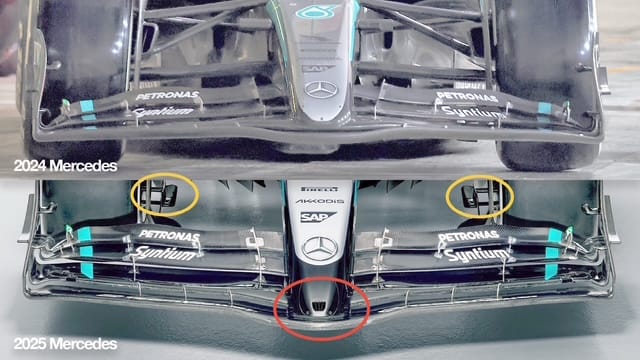After having Lewis Hamilton to focus its Formula 1 car development direction on for the last 12 years, Mercedes now has to change how it works and come up with a concept that will satisfy George Russell and his driving style.
Kimi Antonelli being the new boy in town will be very happy with whatever Mercedes gives him but Russell is now the team leader and in the early stages needs to dig deep into his experience to give the team direction.
As we have seen over the last couple of seasons at least he had the handle on Hamilton most of the time and he did a very good job at Williams when he was its team leader so I’m pretty sure he takes that responsibility with open arms.
It’s all down to the car and the team needs to focus on understanding why last year's car seemed to be so temperature-sensitive and why it lacked consistency because last year on a few occasions Mercedes had the fastest car but even when a weekend started well its competitive edge didn't last.
Let’s have a close look at what Mercedes has revealed of its W16 so far, with the proviso that what we see now might not be what we see during the team's shakedown on Tuesday, pre-season testing later in the week or at the season-opener in Melbourne.
Mercedes has pulled the wool over our eyes in the past and is quite capable of doing the same again.
Front wing
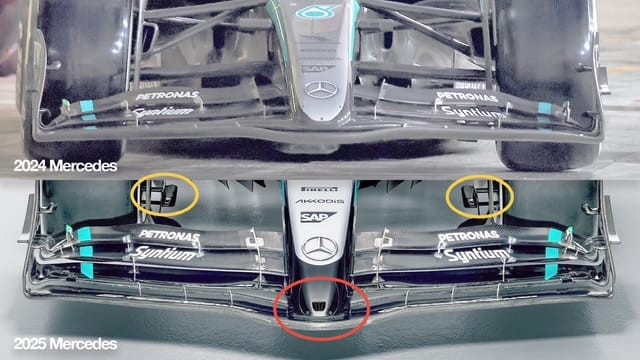
Mercedes' front wing has changed since last year but it’s difficult to see to what degree.
This comparison is from a different angle but it looks like it has loaded it more outboard. It has also run the nose (red ellipse) forward onto the leading flap shutting off the slot gap, which could give it a little more front load at low speeds as it will work that section of the wing harder. But I'm not sure about the airflow consistency to the centre part of the underfloor at high speed when the car is closer to the ground.
Although it probably had something there last year, which is hidden by the front wing, this twin turning vane assembly (yellow ellipse) turns the airflow that is being forced around the inside of the tyre as it rotates onto the track surface into the void behind the tyre contact patch. This reduces the tyre drag and the negative effect that this airflow would potentially have on the underfloor.
Front suspension
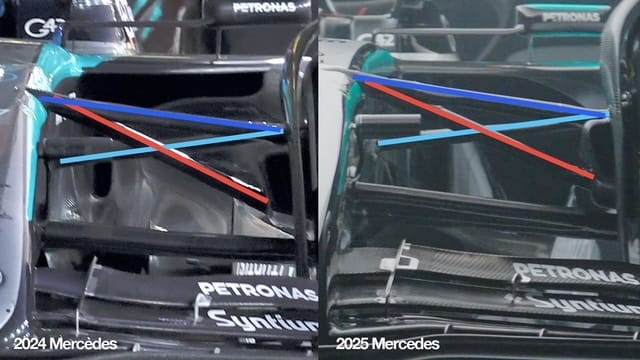
There is a slight difference in the angle of these two pictures which makes the top wishbone look higher but other than that the layout looks very similar to last year. It has a pushrod operated inboard springing mechanism highlighted in red, with the upper wishbone forward leg in dark blue and rearward leg in light blue.
Radiator inlet
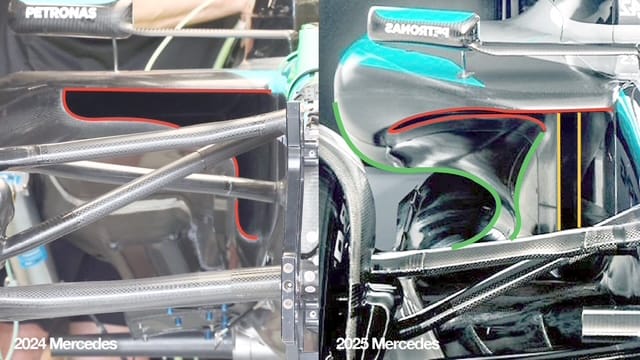
Where other teams seem to have opened up their cooling inlets, Mercedes seems to have really gone to town on minimising its sidepod inlet.
It now has a very small more or less non-existent letterbox (red highlight) and the now common vertical inlet (yellow highlight) bleeding off the boundary layer from the side surface of the chassis.
With all the different body panels in that area, it’s not easy to see exactly where its vertical side inlet is in this side view. I’m pretty sure it’s just rearwards of the letterbox opening.
Sidepod
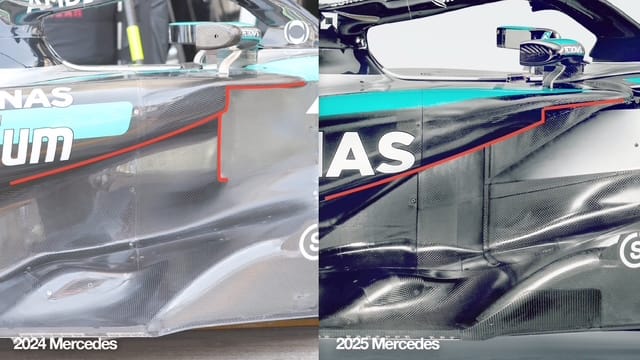
The undercut on the front corner of the sidepod (red highlight) is now more of a full length undercut.
The flow through that area won’t have as much influence on the performance of the front corner of the underfloor, which in turn will have less influence on sealing the second half of the underfloor.
It’s very difficult to see in this picture where the actual vertical inlet is, that is if it’s vertical. Lots of lines on the body panels obscure its actual location.
This concept could very easily mean Mercedes has to run the car very low to get the downforce levels it will require from the underfloor.
Engine cover
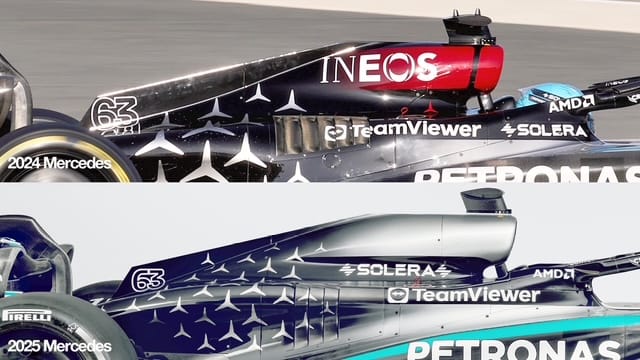
More defined are the now-common cannon exits coming off the drivers' shoulders. The body profile below those cannons sweeps inwards allowing more of the mass flow to get into the middle of the car to the beam wing, diffuser and under the upper wing.
Floor sides
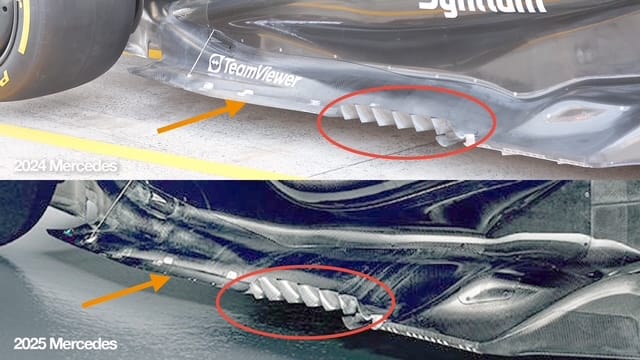
I’m surprised that we are not seeing more differences in this area because I would have thought that three months of aerodynamic research would have brought something to the package.
Both these vanes highlighted with the red ellipse and the floor wing highlighted with the orange arrow look identical to me.
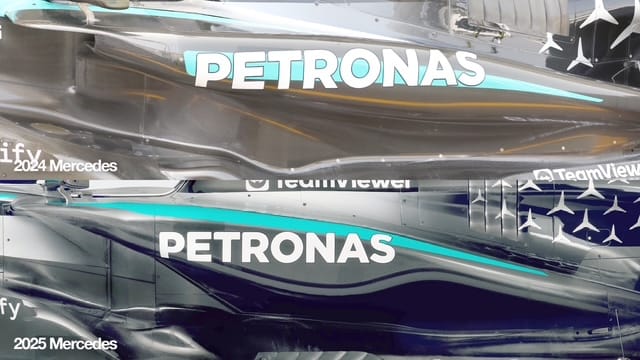
Obviously you have to put the cooling radiators somewhere and this bulge in the sidepod is probably where they are situated. Last year the underside of the sidepod was fairly aesthetically pleasing, now with that bulge it has sort of exaggerated the undercut.
Rear suspension
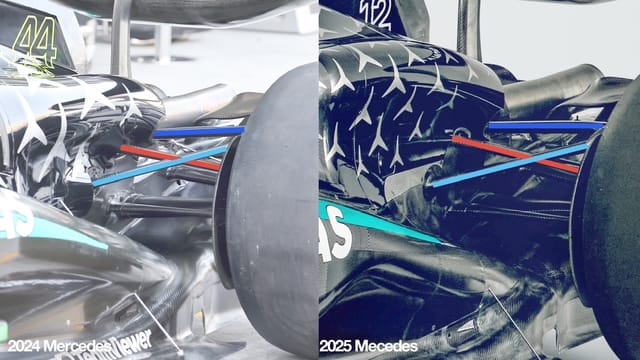
From these shots it is very similar to last year's layout, again a pushrod (red highlight) operated inboard springing mechanism. It seems to have, like Aston Martin which unsurprisingly uses the same rear end assembly, a reasonable amount of anti lift (top wishbone front leg light blue highlight, rear leg dark blue highlight).
This probably goes in line with the sidepod aerodynamic detail. As I said earlier I think Mercedes will need to run the car fairly low to get the best out of the underfloor and if you are doing that, keeping it low during braking is just as important.
Rear wing
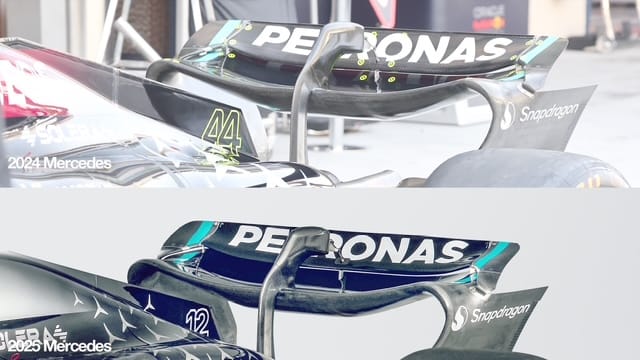
As I have said many times, the rear wing is a bolt-on component and we will see various solutions as the season progresses. This version, if not the same component, looks very similar to last year's.
In conclusion
I’m interested to see how Mercedes performs. I expected more than this in terms of design changes - yes it’s in line with everyone else, but somewhere in there is untapped potential and someone will find it.
Going into a season without a world champion steering it will be a whole new experience for Mercedes. To add to this it has a rookie in the second car, so again a whole new learning curve on how to manage a weekend with someone who is without doubt talented and very fast but needs to learn when to be fast.
2024 performance

Mixing it consistently with the top three teams McLaren, Ferrari and Red Bull in qualifying has got to be the team's objective. Yes it will be dreaming of the dominant years it had prior to the introduction of these ground effect rules, but as time has gone past some of these dreams will have faded away. Just being consistently potentially podium finishers would be a solid step forward in 2025.
I'm not sure Mercedes would be happy with that but sometime this year everyone will move their focus onto the 2026 car, so the early races are critical to show its true potential and get some big points on the table.

